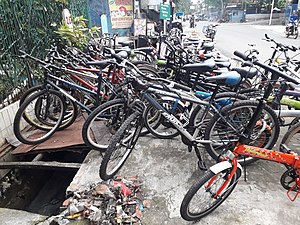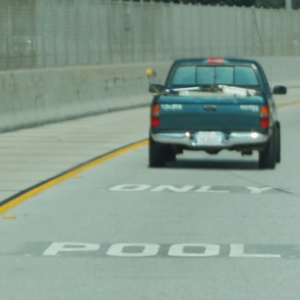
Within urban areas, sustainable transport is a key aspect of creating more sustainable cities.
With the depleting fossil oil reserves, climate warming exacerbated by carbon emissions and high energy prices, the conventional automobile industry is becoming less and less feasible to the conversation of sustainability. Revisions of urban transport systems that foster mobility, low-cost transportation and healthier urban environments are needed. Such urban transport systems should consist of a combination of rail transport, bus transport, bicycle pathways and pedestrian walkways. Public transport systems such as underground rail systems and bus transit systems shift huge numbers of people away from reliance on car mobilization and dramatically reduce the rate of carbon emissions caused by automobile transport.[1] Carpooling is another alternative for reducing oil consumption and carbon emissions by transit.
In general, following vehicles types can be distinguished:
- Water vehicle (includes supersurface water vehicles (regular or hydrofoiling), subsurface vehicles (regular or supercavitating))
- Ground vehicle (includes supersurface ground vehicles, subsurface ground vehicles)
- Air vehicle (includes lighter-than-air air vehicles and heavier-than-air air vehicles)
Most vehicles above can be either:
- Privately owned; see personal water vehicle, personal ground vehicle, personal air vehicle
- Public: see public transport. Public transport vehicles includes cabs, trains, bicycles (Bicycle sharing systems), buses, trucks, helicopters, and aircraft (renting services).
Sustainable transportation
According to the Appropriate transport manual, sustainable transportation is a strategy for the flow of people and goods across the Earth that meets the needs of the present without compromising the ability of future generations to meet their own needs. Transportation accounted for 32.6% of US green house gas emissions in 2005. [1]. In addition to the widely publicized environmental consequences of driving automobiles, it is also socially and economically costly:
- Land use: Parking and roads use valuable land resources.
- Transportation equity: Driving, with all of its expenses, costs the average U.S. household $7,000 per year per vehicle [2].
- Economics: Most of the money spent on driving leaves a local economy, weakening it.
- Community: Travelers outside of their cars interact more with their physical environment and each other.
- Safety: The presence of pedestrians and cyclists make our neighborhoods safer from crime. Conversely, 42,000 Americans are killed in car accidents every year.
- Health: Increasingly, Americans are suffering from weight-related illnesses. This is partly attributable to the decline in active transportation use and availability.
Building and encouraging alternatives to the single-occupant vehicle, or, for short "alternative transportation," is imperative. Some alternative transportation advocates have taken to using the term Sustainable Transportation instead of the previous, widely-used "alternative transportation" term to avoid sidelining their interest from the mainstream. One way of encouraging such reform is changing the technical practice of transport planning to reflect these concerns - see the transport modeling reform page.
Many efficient, practical, and inexpensive sustainable transportation technologies already exist, meaning activism, policy work, and planning research is most often more crucial to developing sustainable transportation than technology development.
Taking action in favor of sustainable transport also include supporting a local car-share program that uses highly fuel efficient vehicles, work with your community officials, attend city council meetings and become involved in your local government in order to influence decision making, help to educate community leaders about the benefits of creating "walkable" and "bicycle-friendly" cities and towns, try to live close to public transport and good bike routes so you have plenty options on commuting and shopping, use your car less and even consider selling it.
Urban public transport
Being early can make it easier to use - and enjoy - public transport or cycling. This helps to avoid having to catch taxis, driving your car, or wishing you still had a car. (As a side-benefit, you might also be a lot more relaxed.) Taking a good book or an e-book might give you more motive to leave early, and have time to read on the train and when you arrive early.
The specific choice depend on where you live, of course. Thats why the house you buy or construct should be chosen to be in proximity to essential services such as grocery stores, schools, daycares, work, or public transit making it possible to commit to sustainable transportation choices.[2] This already greatly reduces your carbon offsets from transport. If there are no practical public transport options, and no safe cycling options, write a letter to your local government.
Bicycles

A bicycle, or bike, is a 2-wheeled vehicle for human transportation. They are generally human-powered by pedals (but see #Electric bicycles too). Bicycles are used for cycling.
While bicycles do take some resources to build and maintain (particularly various metals for frames and rubber for tyres), these are far lower than modern automobiles. Human-powered bicycles also do not require using non-renewable petroleum as a power source, do not emit any air pollution during use, and require far less parking space and heavy road infrastructure per person than is required for automobiles. They are also far less likely to kill and/or seriously injure cyclists or other street users such as pedestrians than heavy, motorised transport.
Consequently, there is much interest and renewed focus in the bicycle as an important part of the goal of Sustainable transport. This includes both in rural developing contexts, in urban centers in countries such as China and India where in many places the bicycle is still a majority form of mass transport, and in Western countries where explicit policies and infrastructure to encourage more cycling is seen as an important way to reduce the environmental impact of transport, and also to support improved public health due to their beneficial mild exercise aspect.
In comparison with automobiles, bicycles are a paradigm of energy efficient personal transportation. Bicycles increase mobility while alleviating congestion, lowering air and noise pollution, and increasing physical exercise. Most importantly, they do not emit climate-disturbing carbon dioxide.[3] Bike-sharing programs are booming throughout the world and are modeled in leading cities such as Paris, Amsterdam and London. Bike-sharing programs offer kiosks and docking stations that supply hundreds to thousands of bikes for rental throughout a city through small deposits or affordable memberships.
Another boom has occurred in electric bikes, especially in China and other Asian countries. Electric bikes are similar to plug-in hybridW vehicles in that they are battery powered and can be plugged into the provincial electric grid for recharging as needed. In contrast to plug-in hybrid cars, electric bikes do not directly use any fossil fuels. Adequate sustainable urban transportation is dependent upon proper city infrastructure and planning that incorporates efficient public transit along with bicycle and pedestrian-friendly pathways.[4]
Carpooling

Carpooling (also car-sharing, ride-sharing, lift-sharing and covoiturage), is the sharing of car journeys so that more than one person travels in a car.
By having more people using one vehicle, carpooling reduces each person's travel costs such as fuel costs, tolls, and the stress of driving. Carpooling is seen as a more environmentally friendly and sustainable way to travel as sharing journeys reduces carbon emissions, traffic congestion on the roads, and the need for parking spaces. Authorities often encourage carpooling, especially during high pollution periods and high fuel prices. W
Alternative fuels

Here you will find different biofuels and other sustainable fuels that can be used as an alternative to conventional fuels.
Transport in developing countries
Isolation is one of the key elements of poverty. Isolated communities have little or no access to goods and services, and few opportunities to travel beyond their immediate surroundings. This restricts agricultural productivity, reduces health and education and limits opportunities for employment and political activity. Limited financial resources prevents investment in transport maintaining the position of poverty and isolation. Consequently, there is a need to develop alternative, more affordable means of transport.
Developing such systems requires consideration of four key elements:
- The improvement of village level infrastructure such as paths, tracks, and footbridges.
- The provision of adequate and affordable rural transport services.
- The siting of services closer to the communities, thereby removing or reducing the need for lengthy travel.
- The promotion and use of intermediate means of transport including: pack animals, sledges, animal carts, cycle based transport and some low cost motorised devices. One of the more common types of intermediate transport is the bicycle.
Organizations
Globally Oriented Transport Policy, Advocacy & Project Organizations
- World Streets (Peer network and advocacy for sustainable, equitable transport)
- Bridges to Prosperity (B2P)
- Victoria Transportation Policy Institute
- The World Resources Institute Center for Sustainable Transport
- International Forum for Rural Transport and Development
- Institute for Transportation and Development Policy
- OurFuturePlanet - Transport and Travel
- Missoula Institute for Sustainable Transportation
- National Center for Transit Research at University of South Florida
- New Mobility Agenda
- One Bike per Person (1BpP)
U.S. Regional Transport Advocacy & Alternatives
- Transportation Alternatives, NYC
- RailVolution - US transit, cycling, smart growth advocacy coalition website
- Reconnecting America - advocacy group for connecting transit with community development
- We Are Mode Shift - advocacy group particularly for Michigan aiming to enhance cycling, walking, and public transit as workable alternatives to the car
U.K. Sustainable Transport Advocacy Organizations
Humboldt County, CA
Books
Transportation and Sustainable Campus Communities by Will Toor and Spenser W. Havlick.
Policy Tools
Transportation Category at MorePerfect.org
See also
Notes and references
- ↑ Brown, Lester R. Plan B 4.0: Mobilizing to Save Civilization. New York: W.W. Norton, 2009.
- ↑ Jeffery, Yvonne, Michael Grosvenor, and Liz Barclay. Green Living for Dummies. Indianapolis, IN: Wiley Pub., 2008. Print.
- ↑ Brown, Lester R. Plan B 4.0: Mobilizing to Save Civilization. New York: W.W. Norton, 2009.
- ↑ Brown, Lester R. Plan B 4.0: Mobilizing to Save Civilization. New York: W.W. Norton, 2009.
External links
- Wikipedia:Adirondack guideboat
- Wikipedia:List of bicycle and human powered vehicle museums
- Wikipedia:Carfree Cities
- Wikipedia:Fuel efficiency in transportation
- Wikipedia:Human-powered transport
- Wikipedia:International Human Powered Vehicle Association
- Wikipedia:Row boat
- Wikipedia:Self-propelled travel
- Wikipedia:Sidewalk
- Wikipedia:Sustainable transportation
- Wikipedia:Utility cycling
- Wikipedia:Watercraft rowing